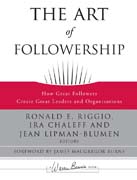
The art of followership: how great followers create great leaders and organizations
Riggio, Ronald E.
Chaleff, Ira
Lipman-Blumen, Jean
The book draws upon various disciplines, from philosophy, to psychology and management, to education, to define and redefine followership and its variety of meanings. It looks at the practice and research that promotes positive followership and examines when and how followers fail to rise to the challenge of active constituency. It draws on multiple disciplines and explores the complex factors that push followers to acquiesce blindly to both good and bad leaders,as well as the intricacies of faulty leader-follower dynamics. Includes the latest research on followership and offers current and future perspectives on followers and the leader-follower relationship. INDICE: Foreword by James MacGregor Burns. Acknowledgments. About the Contributors. Introduction. Warren Bennis. PART ONE: DEFINING AND REDEFINING FOLLOWERSHIP. 1. Rethinking Followership (Robert E. Kelley). 2. Leadership: A Partnership in Reciprocal Following (James Maroosis). 3. Three Perspectives on Followership (Jon P. Howell and MarÃa J. MÃíndez). 4. A New Leadership-Followership Paradigm (Ernest L. Stech). 5. Followership: An Outmoded Concept (Joseph Rost). PART TWO: EFFECTIVE FOLLOWERSHIP. 6. Creating New Ways of Following (Ira Chaleff). 7. Rethinking Leadership and Followership: A Follower’s Perspective (Krista Kleiner). 8. The Hero's Journey to Effective Followership and Leadership: A Practitioner's Focus (Gail S. Williams). 9. Courageous Followers, Servant-Leaders, and Organizational Transformations (Linda Hopper). 10. Followership in a Professional Services Firm (Brent Uken). 11. Developing Great Leaders,One Follower at a Time (Rodger Adair). 12. Getting Together (Gene Dixon). PART THREE: THE PITFALLS AND CHALLENGES OF FOLLOWERSHIP. 13. Following Toxic Leaders: In Search of Posthumous Praise (Jean Lipman-Blumen). 14. What Can Milgram's Obedience Experiments Contribute to Our Understanding of Followership (Thomas Blass)? 15. What Kind of Leader Do People Want to Follow (Michael Maccoby)?16. Bystanders to Children's Bullying: The Importance of Leadership by ‘Innocent Bystanders’ (Lorna S. Blumen). 17. Whistleblowing as Responsible Followership (C. Fred Alford). PART FOUR: FOLLOWERS AND LEADERS: RESEARCH, PRACTICE, AND THE FUTURE. 18. Followers’Cognitive and Affective Structures and Leadership Processes (Robert G. Lord). 19. Social Identity Processes and the Empowerment of Followers (Michael A. Hogg). 20. Lead, Follow, and Get out of the Way: Involving Employees in the Visioning Process (Melissa K. Carsten and Michelle C.Bligh). 21. Effective Followership for Creativity and Innovation: A Range of Colors and Dimensions (Kimberly S. Jaussi, Andy Stefanovich, and Patricia G. Devlin). 22. Conformist, Resistant, and Disguised Selves: A Post-Structuralist Approach to Identity and Workplace Followership (David Collinson). 23. The Rise of Authentic Followership (Bruce J. Avolio and Rebecca J. Reichard). Notes. Index.
- ISBN: 978-0-7879-9665-9
- Editorial: Jossey Bass
- Encuadernacion: Cartoné
- Páginas: 416
- Fecha Publicación: 05/02/2008
- Nº Volúmenes: 1
- Idioma: Inglés
